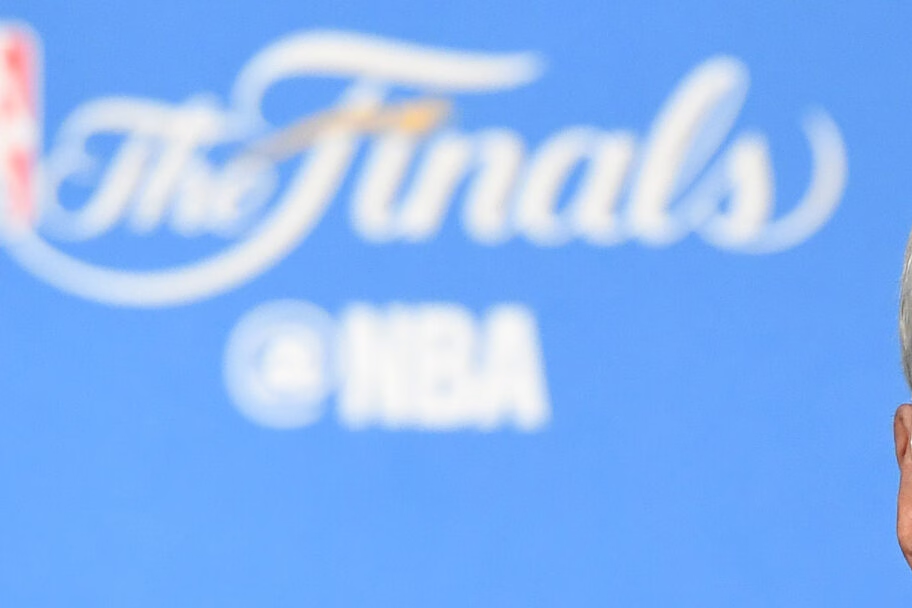With Hubie Brown set to call his final NBA game on Sunday (2 ET, ESPN), we take an All-Access look at the beloved coach and broadcaster.
Hubie Brown is a one-of-a-kind figure in basketball lore.
A two-time NBA Coach of the Year winner, the Naismith Basketball Hall of Famer’s time with basketball spans more than six decades.
His enthusiasm for the game (which he shared with millions as a color commentator and analyst since the 1981-82 season) has always been evident.
As his final broadcast nears — he’ll call Sunday’s 76ers vs. Bucks game (2 p.m. ET, ESPN) — Brown spoke with NBA.com about his life, career and the focus on preparation and communication that drives him to this day.
Editor’s Note: This interview has been lightly condensed and edited for clarity.
NBA.com: Where does your passion for basketball come from? Where did it start for you?
Brown: It goes back to high school (at St. Mary of the Assumption High School in Elizabeth, N.J.). We had one of the best teams in the state, and my senior year, we went undefeated. We won the city, the county and the state, and then I went to college on a basketball scholarship. I played at Niagara University for four years — basketball and baseball. Basketball, we were one of the better teams.
And then I played in the service — I was fortunate to play at the Presidio in San Francisco, and we won the sixth Army tournament two years in a row. We lost the all-Army Finals the first year, in overtime to Fort Dix.
I was fortunate to play at all levels, and even in grammar school, we went undefeated. We went 26-0.
NBA.com: How did you develop your style as a teacher and communicator?
I was nine years teaching in high school and being a coach in three sports, and I taught business law and consumer economics to seniors. I think a lot of that helped me in communications.
There was a basketball camp called the Five-Star Basketball Camp, where Howard Garfinkel and Will Klein were the two owners. It became one of the biggest basketball camps in the country, to the point that it had 400 great players, and it was in the Poconos and then Robert Morris College.
That’s where notoriety as a teacher came about because you had all these great high school All-Americans (including Michael Jordan, Patrick Ewing and Chris Mullin). The camp went on for more than 40 years, and I was always one of the main clinicians.
That’s how I got into college coaching: the coach at William & Mary had an opening, and he saw me lecturing at the Five-Star camp. If you were any type of a college team, you were there looking at these players, because that’s how good the quality of players were.
NBA.com: Why did you do so many clinics? You’re one of the great teachers of the game.
It became a business for me because I was then invited to all summer camps — up and down the Eastern seaboard, all the way into the South — where you would get a fee for lecturing and being your standout lecturer from the day.
From high school to the Five-Star Basketball Camp, that gave you exposure to a lot of coaches. Two hundred coaches that applied for (Howard Garfinkel’s breakdown of players). Naturally, you’d want to be one of the top speakers there, and then it became a great summer business.
It also developed your philosophy, because the game was not played the same in the Northeast as it was played in the Midwest or the Southwest. That was an education — where you could take it or leave it — if you believed in that type of philosophy.
At night, the camp would close, and the college coaches would stay out until two in the morning, talking about different philosophies.
NBA.com: Are there players you coached that you think would thrive today, in this more open, shooting-based game?
The game has changed so much, from when I was playing in high school in the 1950s to today. [There’s] the widening of the lane, no hand-checking, no hard fouls, two referees vs. three referees.
I’m going to name you nine guys — they’re all in the Hall of Fame — that I was fortunate enough to coach.
In Milwaukee, when I entered the league as an assistant, there was Oscar Robertson, Kareem Abdul-Jabbar and Bobby Dandridge. When I got my first head coaching job in the ABA, my center was Artis Gilmore, my power forward was Dan Issel, and our top guard was Louis Dampier.
When I coached the Knicks, we had Bernard King, and then Patrick Ewing became a Hall-of-Famer. And when I came back to coach Memphis, we had this young man from Spain who was a teenager: Pau Gasol.
Those guys could play at any level, at any time, period, because they were complete, and they were able to dominate in their time periods. I wanted to tell you about the nine guys because you learn not just what they’re talented in, but their attitude, their work habits, and whether they emerge as total team players.
Legendary coach and broadcaster Hubie Brown sits down with Matt Winer to talk about what he’s seen throughout his years in basketball
NBA.com: What do you hope fans take away from listening to you over the years? Why did broadcasting appeal to you?
When I was first contacted, the USA Network had Thursday night doubleheaders: an East Coast game and a West Coast game. They gave me an opportunity, and I worked with Al Albert (the younger brother of the Alberts, Marv and Steve) for a year. By the time the year ended, CBS came to us and offered Kevin Loughery, who was coaching in New York, and myself, to do a pregame, halftime and postgame show.
Over 12 months, I learned quickly and you become an individual with a style, connecting with the audience. You always want to be able to see all 10 players: can you break down what just happened? This isn’t football or baseball, where when you come in you’ve got 20 seconds. In the NBA, we’ve got five to eight seconds to tell you what just happened, to teach what happened, what you might have missed as a fan.
You have to have a really good working technique with your announcer. He can either take up your time or he can give it to you quickly. You want to be a teacher. You want the fan to listen hard and understand why things happen, and then you want to be a team player, so you and the announcer are on the same page as the producer and the director.
What I see, I have to explain. I want to be able to explain it at a level that all ages watching can relate to. You want to stay within the vocabulary of the sport, and you also want to be able to reach any fan, from a youngster in grammar school to the old pro to those who have been watching for years. I talked to the fan like I talked to an assistant coach next to me or one of the players on the bench. To me, I thought the fan deserved that type of tempo, that type of knowledge.
Just like when you’re teaching in a classroom … if the class is 55 minutes, you’re trying to give them 55 minutes of material, so it’s not above their heads, it’s breaking down to their level, so they retain what you’re talking about.
We popularized statistics at USA, and then at CBS. Early on, some people said ‘Your style is too statistics-and-terminology-based.’ How else does the fan learn? How else does the fan learn, unless you talk about it? You’ve got to be able to educate and get that fan to widen his view.
I never underestimate the IQ of the audience. That forces you to prepare. Now, that’s a lot of pressure, if you’re constantly thinking about that: never underestimate the IQ of the person watching. It was the same in class, when I had 35, 38 students watching. That’s how you feel, when a company puts you on the air, especially when you’re not talking to people in the United States.
You don’t just have the responsibility of communicating just here in the country. You’re communicating to the world, which has accepted the NBA.
In this throwback clip, Hubie Brown talks with NBA star Hakeem Olajuwon before the 1989 All-Star Game.
NBA.com: What does it mean to you to be part of basketball history, in your way?
I have to say, it’s a long way from 126 Burnet St. in Elizabeth, N.J., where I grew up.
You can’t be at this level, and doing it for 35 years, without appreciating the people who opened the doors. In life, you’re advancing, you’re doing the best. As you move up, from coaching at the different levels, to television, you’re constantly moving, but you’re constantly moving financially, for your family.
So you never lose sight of the fact that you’re making a reputation, and B, sums of money in a position, in a job, that you thoroughly enjoy. You enjoy the camaraderie, the preparation, and then the delivery — and also you love the paycheck, which goes hand-in-hand with notoriety.
I was never not happy being a high school coach, coaching three sports. From William & Mary to Duke, to the ABA and back to the NBA, somebody saw and opened the door, and you stepped through. Once you accept stepping through, then it’s the delivery.
Will you put in the preparation? Will you put in the camaraderie? And then, can you produce and can you communicate to the audience?
NBA.com: What does it mean to you to be getting ready for this last game? Is anything special planned?
I will prepare for this game like I prepared for all those years doing television. I will still watch both teams, two full games, and do my notes. I will go back to my pamphlet, my file, on every single team. That allows you to see the starters, the subs, what the teams are running, including at the end of games.
Then you’re in advance of it, you’re not seeing it for the first time. So then, you go back over the history of all these teams, and you bring that into the telecast (if it allows, because you never know if the speed of the game, the timeout, the injuries, will give you space to fill it with knowledge for the fan).
Looking at this game, both the Bucks and 76ers have been hurt with injuries. At the beginning of the season, you would have thought Milwaukee and Philadelphia would have been right there with Boston, maybe first, second and third. But because of injuries, especially to Philadelphia, they’re in the middle of the pack right now.
I’m hoping they’re going to be healthy, and everybody’s going to play in this game, so we can give the fans a little — what can they do if they stay healthy in the second half of the season? Then, can they reach their potential at playoff time? But they’ve got to make the playoffs.
That’s what you want to get across to the fan: specific pluses and minuses of the game itself. Where would announcers be if there were no fans? You always want to educate the fans and raise their IQs.
You want the fan to be able to be on top of that, so that when they turn off the game, the education is great, but it was really good because it happened in a nail-biter, right to the end, and you saw both teams, offensively and defensively, and the coaching staff, at their best. That’s what you want to do.



